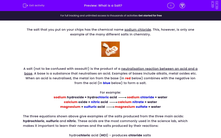The salt that you put on your chips has the chemical name sodium chloride. This, however, is only one example of the many different salts in chemistry.
.jpg)
A salt is the product of a neutralisation reaction between an acid and a base. A base is a substance that reacts with an acid to form a salt and water only. This means that metal oxides and metal hydroxides are bases.
Some bases are alkalis - only ones that are soluble in water are called alkalis
For example:
copper oxide is a base, but it is not an alkali because it is insoluble in water
sodium hydroxide is a base, and it dissolves in water so it is also an alkali
Remember acids have a pH less than 7. Acids in solution are sources of hydrogen ions, H+
Bases have a pH of more than 7. Alkalis in solution are sources of hydroxide ions, OH-
When an acid is neutralised by a base, the metal ion from the base (in red below) combines with the negative ion from the acid (in blue below) to form a salt.
But where does the water come from?
Well the hydrogen ions from the acid react with hydroxide ions from the alkali to form water, giving it a neutral pH of 7.
H+ + OH- → H2O
The salts formed have particular names depending on the acid and base used.
For example:
sodium hydroxide + hydrochloric acid ![]() sodium chloride + water
sodium chloride + water
calcium oxide + nitric acid ![]() calcium nitrate + water
calcium nitrate + water
magnesium + sulfuric acid ![]() magnesium sulfate + water
magnesium sulfate + water
The three equations shown above give examples of the salts produced from the three main acids: hydrochloric, sulfuric and nitric. These acids are the most commonly used in the science lab, which makes it important to learn their names and the salts produced by their reactions:
hydrochloric acid (HCl) - produces chloride salts
sulfuric acid (H2SO4) - produces sulfate salts
nitric acid (HNO3) - produces nitrate salts
That's a lot to remember but it is important stuff!
You can look back at this introduction at any point during the activity by clicking on the red help button on the screen.
Are you ready to get started?







